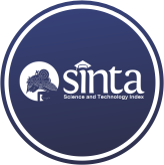Penerapan Deep Learning untuk Prediksi Kasus Aktif Covid-19
(1) Universitas Muhammadiyah Malang
(2) Universitas Muhammadiyah Malang
(*) Corresponding Author
Abstract
Full Text:
PDFReferences
DSÖ, “Naming the coronavirus disease (COVID-19) and the virus that causes it,” World Health Organization. p. 1, 2020, [Online]. Available: https://www.who.int/emergencies/diseases/novel-coronavirus-2019/technical-guidance/naming-the-coronavirus-disease-(covid-2019)-and-the-virus-that-causes-it.
N. Chen et al, “The epidemiological characteristics of an outbreak of 2019 novel coronavirus diseases (COVID-19) in China,” Zhonghua liu xing bing xue za zhi = Zhonghua liuxingbingxue zazhi, vol. 41, no. 2. pp. 145–151, 2020, doi: 10.3760/cma.j.issn.0254-6450.2020.02.003.
C. Huang et al., “Clinical features of patients infected with 2019 novel coronavirus in Wuhan, China,” Lancet, vol. 395, no. 10223, pp. 497–506, 2020, doi: 10.1016/S0140-6736(20)30183-5.
K. Liu et al., “Clinical characteristics of novel coronavirus cases in tertiary hospitals in Hubei Province,” Chin. Med. J. (Engl)., vol. 133, no. 9, pp. 1025–1031, 2020, doi: 10.1097/CM9.0000000000000744.
L. Van Der Hoek et al., “Identification of a new human coronavirus,” Nat. Med., vol. 10, no. 4, pp. 368–373, 2004, doi: 10.1038/nm1024.
N. Materials, “Ascent of machine learning in medicine,” Nat. Mater., vol. 18, no. 5, p. 407, 2019, doi: 10.1038/s41563-019-0360-1.
G. Bontempi and S. Ben Taieb, “Machine Learning Strategies for Time Series Forecasting,” no. January, 2013, doi: 10.1007/978-3-642-36318-4.
P. Lapuerta, S. P. Azen, and L. LaBree, “Use of neural networks in predicting the risk of coronary artery disease,” Computers and Biomedical Research, vol. 28, no. 1. pp. 38–52, 1995, doi: 10.1006/cbmr.1995.1004.
K. M. Anderson, P. M. Odell, P. W. F. Wilson, W. B. Kannel, and M. P. H. Framingham, “Cardiovascular disease risk profiles.”
H. Asri, H. Mousannif, H. Al Moatassime, and T. Noel, “Using Machine Learning Algorithms for Breast Cancer Risk Prediction and Diagnosis,” Procedia Comput. Sci., vol. 83, no. Fams, pp. 1064–1069, 2016, doi: 10.1016/j.procs.2016.04.224.
DOI: http://dx.doi.org/10.30645/j-sakti.v5i1.337
Refbacks
- There are currently no refbacks.
J-SAKTI (Jurnal Sains Komputer & Informatika)
Published Papers Indexed/Abstracted By:
Jumlah Kunjungan :











